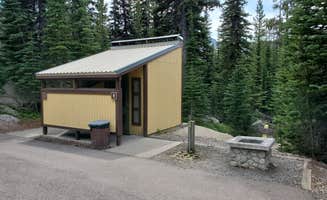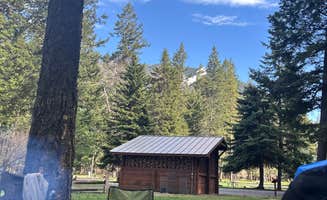Cabins near Durkee, Oregon offer camping options in northeastern Oregon's high desert terrain, ranging in elevation from 2,000 to 4,500 feet. Summer temperatures can reach 95°F while winter nights often drop below freezing, making seasonal planning essential. Most rustic accommodations in this region require advance booking, with peak season running May through September when cabin availability becomes limited.
What to do
Fishing access: At Unity Lake State Recreation Site, visitors can enjoy trout fishing from shore or boat. "Sunsets were beautiful but we stayed during a very hot week and the lack of shade made it very difficult to stay cool," notes one camper, adding that despite water quality concerns, "Kids swam and had a good time in the cool water."
Historical exploration: Many cabins provide easy access to Oregon Trail historical sites within 30-minute drives. "We loved this hidden gem of a campground. We'll definitely be back. Even with a weboost, cellular was poor. However, with the WeBoost, we could text and call," reports a visitor who explored the surrounding historical areas.
Mountain excursions: Wallowa Lake State Park Campground serves as a gateway to alpine adventures. "We took the tram up and visited a mountain summit 3700 feet above our location at the campground. There were numerous hiking trails, and fishing was a popular pastime for many campers," describes one visitor. The alpine tram operates daily from mid-May through October, with adult tickets running $38 round-trip.
What campers like
River sounds: Riverside cabins provide natural white noise for sleeping. At Blackhorse Campground, "River sound drowns out noises from the road or other campers. Sites are spacious and toilets were pristine," mentions one review. Most riverside cabin sites feature easy water access for wading during summer months.
Seasonal variety: Fall visits offer changing colors and fewer crowds. "Great sites especially in fall with aspen groves. Dusty road but all gravel- drove in with my little Nissan Sentra just fine," notes a camper at Fish Lake Campground. Many cabin areas showcase colorful aspens from mid-September through early October.
Wildlife viewing: Early mornings at cabins provide opportunities for wildlife spotting. "There was easy river access from the camp and you can hear the coyotes yipping in the morning," explains a camper. Most cabins in the region sit near wildlife corridors where deer, elk, and various bird species are commonly seen at dawn.
What you should know
Weather patterns: Wind affects many cabin sites in this region. "It was the windiest night I've ever experienced camping. The camp host graciously let us move up to B loop, since it wasn't very busy mid-week," reports a visitor to Farewell Bend. Many exposed cabin sites experience strong afternoon winds, particularly during spring and fall.
Road access: Some remote cabin locations require extended travel on unpaved roads. "This place is quiet, comfortable, and secluded. It's near the end of 18 miles of unpaved mountain road and some of the most spectacular mountain scenery along the way," explains a visitor to Two Color Guard Station. High-clearance vehicles are recommended for accessing remote cabin sites during spring thaw or after rain.
Water availability: Not all cabin areas provide potable water year-round. "Unfortunately they had water hookups shut off for winter (after we made our reservation, but before we arrived). So we had to venture back out to the design acted water fill campsite our first morning," explains one camper about seasonal water limitations.
Tips for camping with families
Bug preparation: Insect activity varies by season and location. "Nice little camp ground right on the unity lake reservoir. Camp was quite, people were friendly. Showers were free. Bring lots of bug spray, they were everywhere," advises a camper about summer visits. Mosquito activity is typically highest May through July near water sources.
Activity options: Some cabin areas provide family-friendly amenities within walking distance. At Park At The River, "There are all kinds of amenities within walking distance: stores, restaurants, mini golf, etc." Multiple cabin locations offer activity rentals like boats, paddle boards, and fishing gear during peak season.
Space considerations: Cabin sizes vary significantly throughout the region. "We stayed at site 2, it was huge and very private. All the sites have river access. Vault toilets, no water or garbage removal," notes a visitor about Blackhorse Campground. Family-sized cabins typically require booking 4-6 months in advance for summer dates.
Tips from RVers
Hookup limitations: Electric service varies between cabin areas. "T Mobile reception good download speed 53Mbs. Wifi would periodically drop out, otherwise was able to stream. Nice shady park. Site 27 the 30amp outlet was troublesome. It does not hold plug well," notes an RVer about technical challenges.
Market access: Some cabin areas provide on-site supplies. "Full service stop over RV Park in the mountains between Idaho and Oregon in Baker City oregon. Full hookups pull throughs a small shop and a great little town," explains a visitor to A-Frame RV Park. Most cabin areas require bringing all supplies, with resupply points typically 20-30 minutes away by vehicle.
Site selection: RV pad locations affect comfort and views. "Large campground with decent facilities. beautiful lake access. take the time to visit chief Joseph," suggests a camper. Corner sites typically offer more privacy and better views, with premium spots requiring reservations up to 9 months in advance.



